Best Learning Management Systems in 2025
Explore the top Learning Management Systems of 2025, highlighting features that cater to diverse educational needs and training goals.
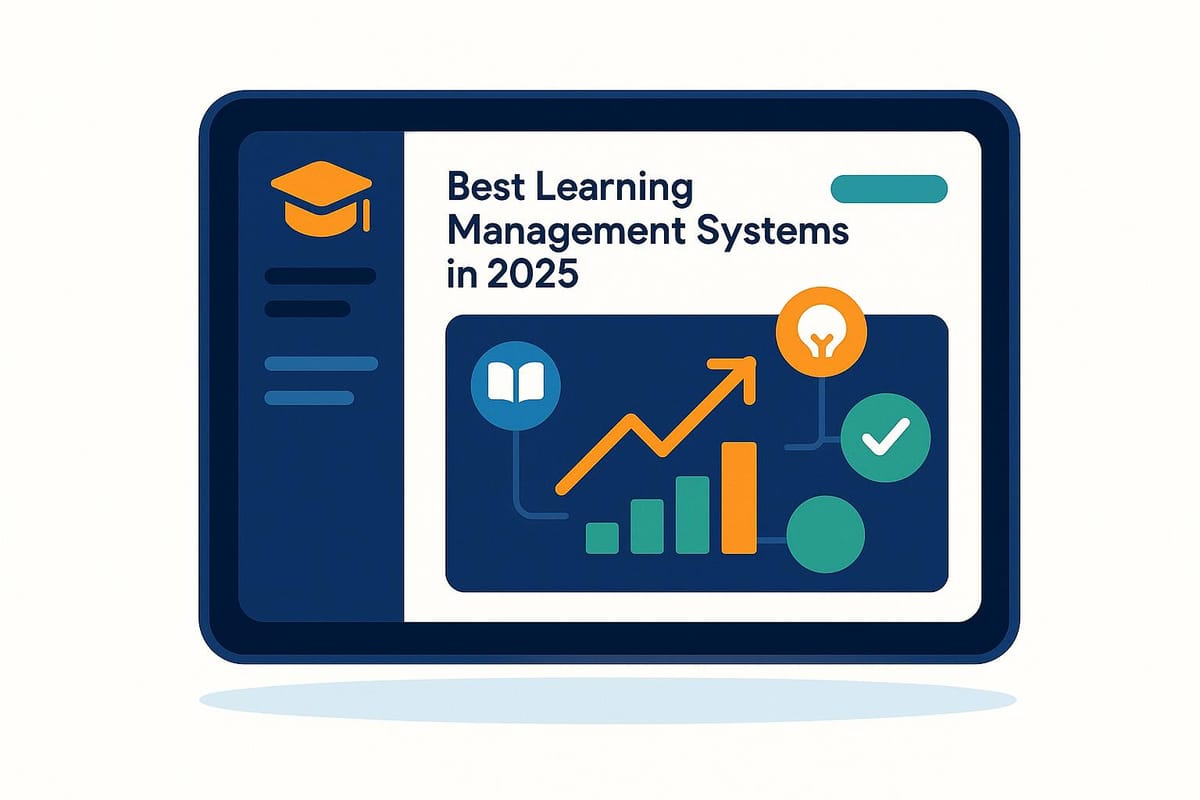
Learning Management Systems (LMS) have transformed into powerful tools for education and professional development in 2025. Whether you're an individual seeking career growth or a business aiming to train employees, there’s an LMS tailored to your needs. Here’s a quick summary of the top platforms and their standout features:
- Upskillist: Offers globally recognized certifications, AI-powered personalized learning, and lifetime access to over 100 subjects.
- Absorb LMS: Ideal for large enterprises with complex training needs, featuring detailed analytics and custom certificates.
- Blackboard Learn: A favorite in academic settings, featuring tools for grading, assignments, and real-time collaboration.
- Canvas LMS: Known for its intuitive design and multimedia integration, making it popular in schools and universities.
- TalentLMS: Perfect for small to medium-sized businesses, offering quick setup and gamification features.
- Litmos: Focuses on mobile-friendly training with a library of 2,900+ pre-built courses.
- Moodle: A free, open-source option for organizations with technical expertise, offering high customization.
- Docebo Learn: Excels in AI-driven course recommendations and multi-domain training for mid-to-large enterprises.
- Skilljar: Designed for customer training, helping businesses onboard users and reduce support costs.
- WorkRamp: Manages training for diverse audiences, including employees, customers, and partners, with unified reporting.
Each platform caters to different audiences, from academic institutions to global corporations. Pricing varies, with some offering free trials and others requiring custom quotes based on user numbers or features. AI and mobile accessibility are key trends shaping LMS in 2025, ensuring personalized and flexible learning experiences.
Quick Comparison
| Platform | Best For | Key Feature | Pricing Model |
|---|---|---|---|
| Upskillist | Personal & professional growth | AI tools, accredited courses | 7-day free trial, subscription |
| Absorb LMS | Large enterprises | Advanced analytics, custom certificates | Per-learner pricing |
| Blackboard | Academic institutions | Grading tools, collaboration | Institutional licensing |
| Canvas LMS | K-12 and higher education | Intuitive design, multimedia tools | Custom pricing |
| TalentLMS | Small to medium businesses | Gamification, quick setup | Subscription plans |
| Litmos | Corporate training | Mobile-friendly, pre-built courses | Per-user pricing |
| Moodle | Budget-conscious organizations | Open-source customization | Free (hosting costs apply) |
| Docebo Learn | Enterprises | AI-driven recommendations | Per-active-user pricing |
| Skilljar | Customer education | Branded portals, API integrations | Custom pricing |
| WorkRamp | Multi-audience enterprises | Unified training, analytics | Subscription-based pricing |
Choosing the right LMS depends on your goals, budget, and technical requirements. Dive deeper into each platform to match its features with your needs.
Top 10 LMS Platforms Ranked for 2025! honest review
1. Upskillist

Upskillist takes a fresh approach to education, offering goal-focused courses designed by experts. It caters to learners across the globe, providing programs that are easy to navigate. Whether you want to launch a business, boost your career, or dive into a new hobby, Upskillist equips you with practical skills that deliver noticeable results.
Features
Upskillist provides accredited courses in over 100 subjects, with certifications that are recognized worldwide. The platform includes interactive classes with lifetime access, so you can revisit lessons whenever you need. Progress tracking through continuous assessments helps you stay on course, and businesses can take advantage of flexible training solutions tailored to organizational needs.
Target Audience
Upskillist is ideal for professionals looking to advance in their careers, individuals building business expertise, or anyone exploring personal interests. It’s also a great fit for corporate teams, entrepreneurs, and small business owners seeking customized training programs to meet specific learning goals. Plus, its pricing options are designed to accommodate a wide range of learners.
Pricing
Upskillist offers a 7-day free trial that grants full access to premium courses and AI-driven learning features. After the trial, learners can continue with a monthly subscription plan, which is flexible and can be canceled anytime.
AI/Personalization Tools
Upskillist integrates AI-powered tools like Compass AI and Pathfinder to create personalized learning experiences. These tools help tailor your courses to match your individual goals and objectives.
2. Absorb LMS
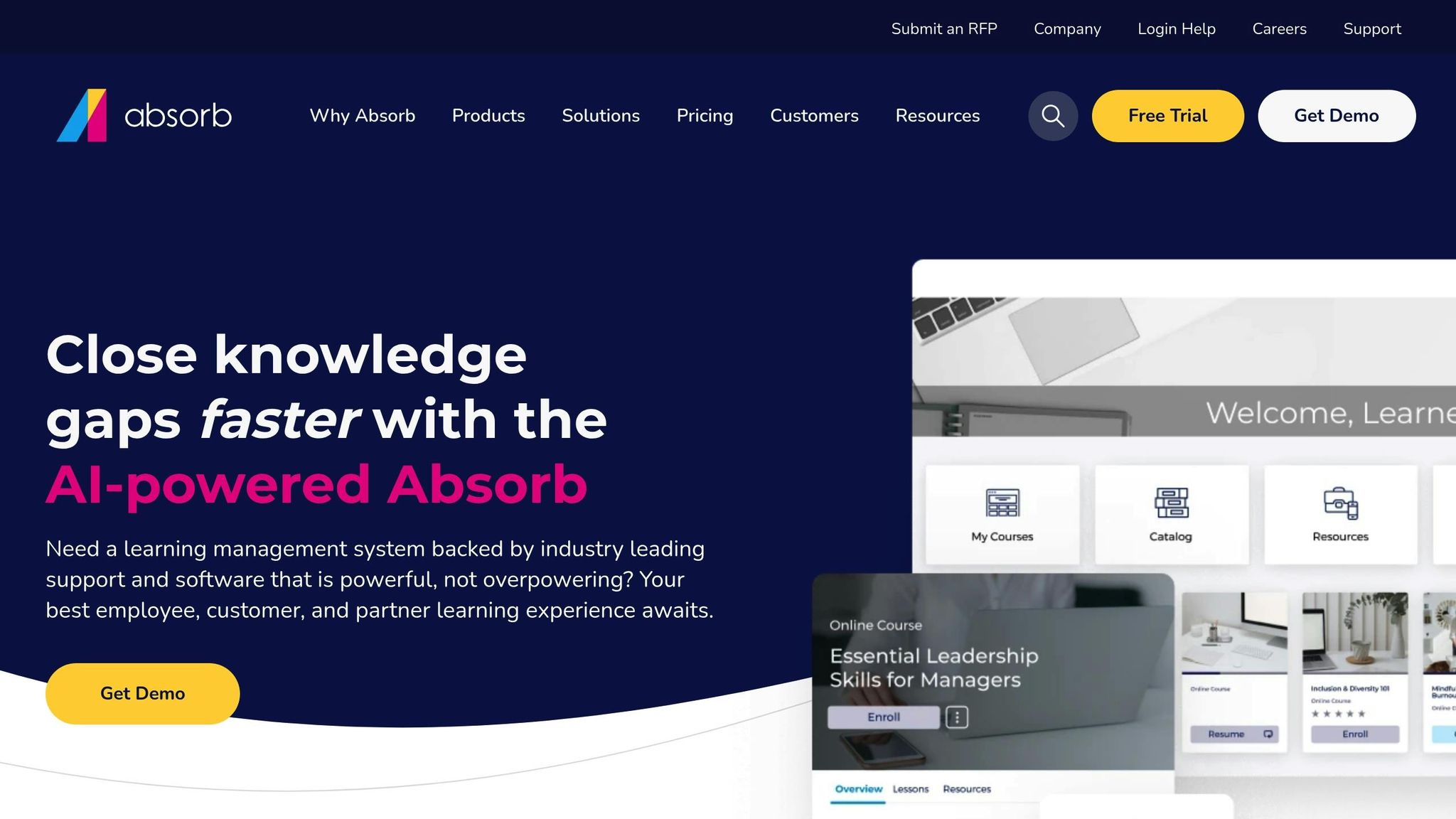
Absorb LMS is a cloud-based learning management system designed to simplify training delivery while enhancing both user experience and administrative efficiency. It combines intuitive training tools with detailed analytics and reporting to streamline the learning process.
Features
Absorb LMS offers a responsive design that works seamlessly across various devices and supports multiple content formats. Automated enrollment simplifies course assignment by using roles or predefined criteria, while structured learning paths guide users through their training journey. The platform also includes white-labeling options, allowing organizations to customize the interface to reflect their branding.
Target Audience
With its flexibility and range of features, Absorb LMS is a great fit for organizations with complex or wide-ranging training requirements. It's particularly useful for companies operating across multiple departments or locations, as well as those in industries where compliance and thorough documentation are essential. Additionally, training providers who deliver courses to external audiences will find this platform highly effective.
Pricing
Absorb LMS uses a per-learner pricing model with tiered options to accommodate various organizational needs. For specific pricing details and implementation plans, you'll need to contact the vendor directly.
Certification Options
The platform includes a certificate builder, enabling administrators to design custom-branded certificates for their learners. It also supports tracking and maintaining certification records, helping organizations manage professional development efforts with ease.
AI and Personalization Tools
Absorb LMS integrates adaptive learning technology to create a more tailored training experience. By analyzing learner progress, the system adjusts content delivery and provides personalized course recommendations, ensuring a more effective learning journey.
3. Blackboard Learn
Blackboard Learn has long been a go-to Learning Management System (LMS) for academic institutions. It combines modern learning tools with support for traditional classroom setups, making it a versatile option for educators and students alike.
Features
Blackboard Learn supports both synchronous and asynchronous learning, giving educators and students the flexibility to interact in real-time or at their own pace. Key features include discussion forums, an integrated gradebook, and assignment submission tools equipped with plagiarism detection.
The platform also allows embedding of videos, interactive presentations, and external content, enhancing lesson delivery. With mobile access, students can complete coursework from any device, while collaboration tools enable group projects and peer-to-peer learning.
Educators can create interactive lessons using content authoring tools, and the platform’s analytics dashboards provide insights into student engagement. These dashboards help instructors identify students who may be struggling, allowing early intervention to improve outcomes.
Target Audience
Blackboard Learn is designed for colleges, universities, and K-12 school districts that need a robust academic management system. It’s particularly useful for institutions managing large student populations spread across multiple departments and programs. Schools that rely heavily on integrating student information systems, library resources, and campus technology will find this platform especially fitting. Additionally, it supports continuing education programs and professional development initiatives in academic environments.
Pricing
Blackboard Learn operates on an institutional licensing model, with pricing tailored to enrollment numbers, desired features, and the chosen deployment method (cloud-based or on-premises). Costs are typically negotiated through annual or multi-year contracts, reflecting the platform’s focus on academic institutions.
AI and Personalization Tools
The platform leverages predictive analytics to help educators identify students at risk of falling behind. By analyzing engagement levels, assignment submissions, and assessment performance, it generates early warning indicators for instructors. Blackboard Learn also offers adaptive learning tools that adjust content delivery based on individual student performance, creating a more personalized learning experience.
4. Canvas LMS
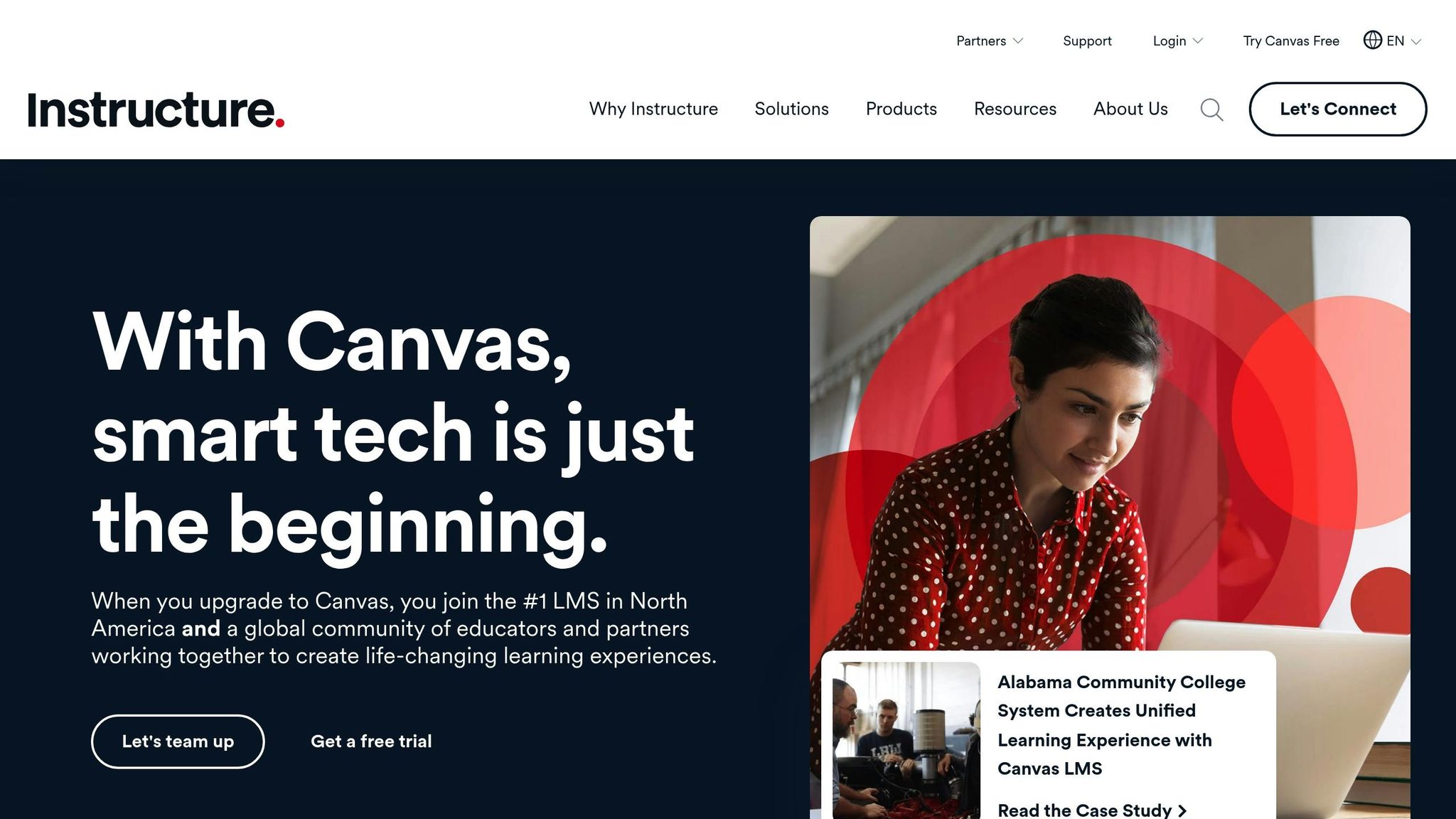
Canvas LMS is a cloud-based learning management system designed with user experience and accessibility in mind. Developed by Instructure, this platform has become a favorite among academic institutions thanks to its easy-to-use interface and a suite of powerful tools. Let’s take a closer look at what makes it a top choice for educators and students alike.
Features
Canvas LMS simplifies course creation, giving educators the tools to design engaging and interactive learning experiences. Its content editor allows for seamless integration of multimedia elements like videos, audio, and other interactive features directly into course materials. With SpeedGrader, instructors can provide feedback quickly and efficiently, all within a single interface.
The platform also supports real-time collaboration through built-in conferencing tools and discussion boards, making it easier for students and teachers to connect. Its calendar feature automatically updates with assignment deadlines and course events, helping students stay on top of their schedules. Plus, the mobile apps for iOS and Android ensure that learning and teaching can happen anytime, anywhere.
For those who need customization, Canvas LMS’s API-first architecture enables smooth integration with a variety of third-party tools and services. These capabilities make it a flexible and reliable choice for academic institutions.
Target Audience
Canvas LMS is tailored for educational settings, making it an ideal choice for colleges, universities, and graduate schools. It’s also widely adopted by K–12 districts, particularly those implementing one-to-one device programs or blended learning models. Its mobile-first design and user-friendly interface make it accessible for educators and students across a wide range of learning environments.
5. TalentLMS
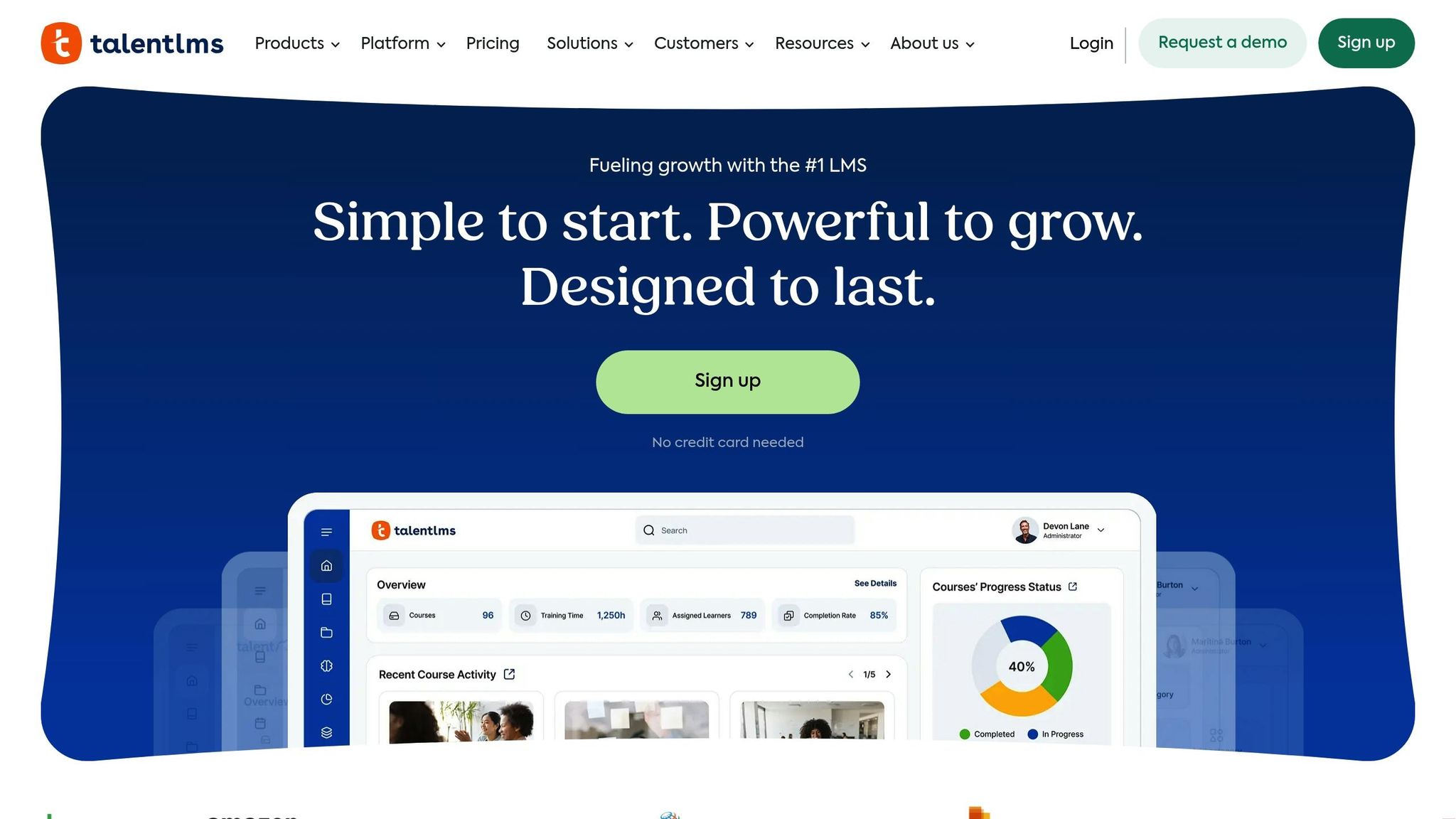
TalentLMS, created by Epignosis, stands out as a cloud-based platform designed to simplify training for organizations of all sizes. With its straightforward interface and practical tools, it’s a go-to solution for delivering effective online learning.
Features
TalentLMS offers a range of tools to enhance the learning experience. Instructors can design engaging courses using a variety of content formats, while built-in gamification keeps learners motivated. The platform also supports mobile access, making it easy for users to learn on the go, and includes analytics to monitor progress and performance.
Target Audience
This platform is a great fit for small to medium-sized businesses, as well as training professionals and course creators who want an efficient way to deliver their content.
6. Litmos
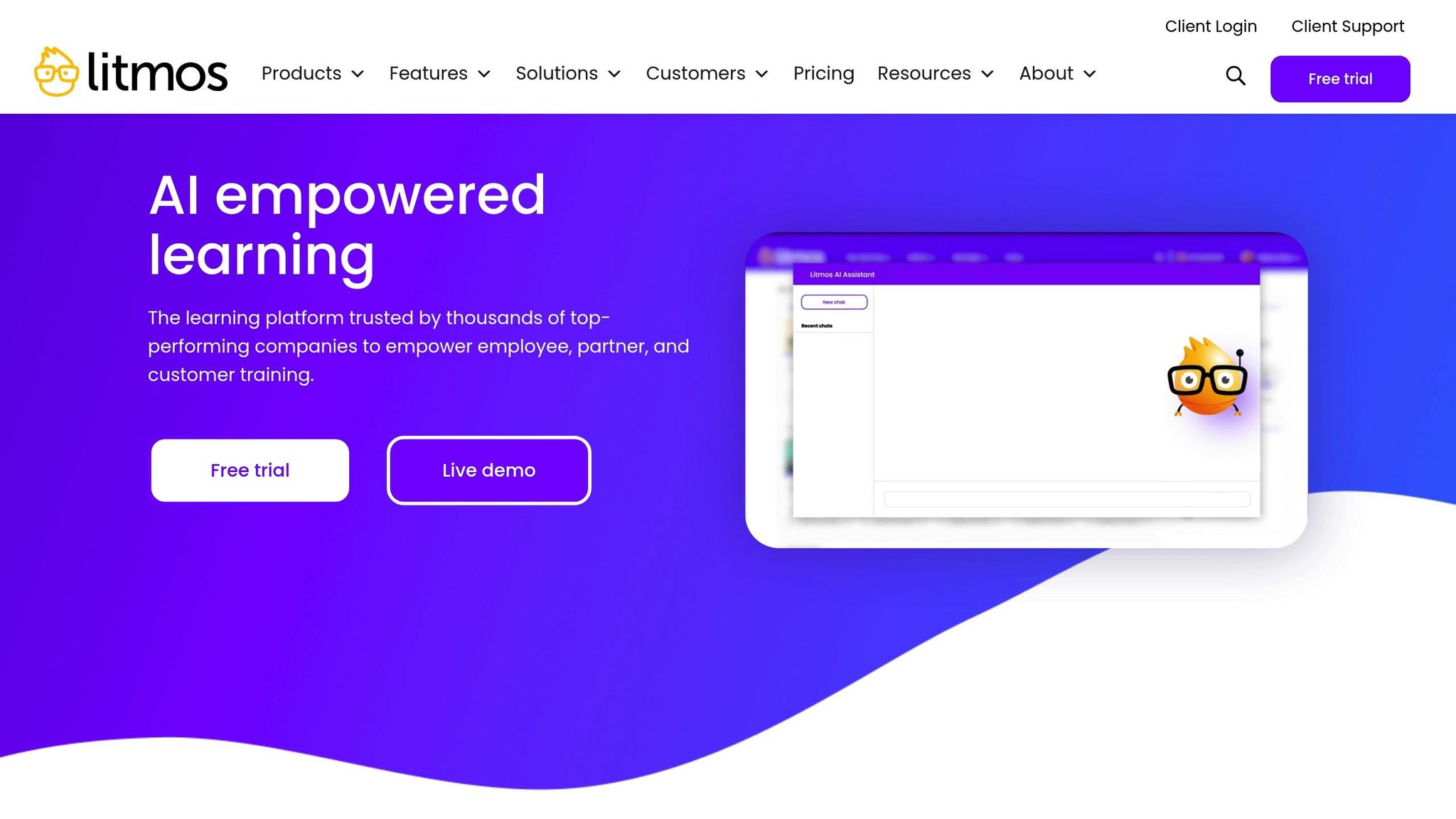
Litmos brings AI-driven learning to the fingertips of 30 million users across 150 countries, supporting over 4,000 organizations with its trusted platform.
Features
One standout feature is Litmos's AI content authoring tool, which simplifies course creation. It generates dynamic, mobile-friendly content that adheres to SCORM compliance, eliminating the need for extra software. This makes developing courses faster and hassle-free.
Litmos also boasts a content library with over 2,900 pre-built courses, covering topics like compliance, leadership, sales, and professional skills. The library is regularly updated to align with the latest industry trends and best practices.
The platform is designed for quick deployment, allowing organizations to get started in minutes rather than months. With 30+ pre-built connectors and open APIs, Litmos integrates smoothly with tools like Salesforce and other enterprise systems, making it easy to connect with existing workflows.
Litmos supports various learning methods, including asynchronous courses, live virtual classrooms, blended learning formats, and offline mobile access. Training is available in 35 languages, making it a strong choice for global teams.
To measure success, the platform offers robust analytics, complete with automated scheduling and visual dashboards, giving clear insights into learner progress and return on investment.
Target Audience
Litmos is tailored for large enterprises and extended enterprises that need scalable training solutions for millions of users. It’s especially effective for organizations focused on compliance training, sales enablement, and professional development across multiple locations and languages.
Pricing
Litmos provides two annual subscription plans:
- Litmos Pro: Starts at $6 per user/month for 150–500 learners, with rates dropping to $4 per user/month for 501–1,000 learners. Larger groups can request custom pricing.
- Litmos Pro+Courses: Includes the content library, starting at $15 per user/month for 50–150 learners, $9 per user/month for 151–500 learners, and $6 per user/month for 501–1,000 learners.
A 14-day free trial for up to 20 users provides full access to the platform's AI-powered features.
AI/Personalization Tools
Litmos takes personalization to the next level with AI that goes beyond content creation. It offers custom learning paths and automated course recommendations, which analyze learner behavior and performance to suggest relevant training, ensuring better outcomes.
Since 2022, users have completed over 34,000 courses on the platform. Customers have also reported saving $192,000 on onboarding and training costs, thanks to Litmos's AI-enhanced efficiency.
7. Moodle
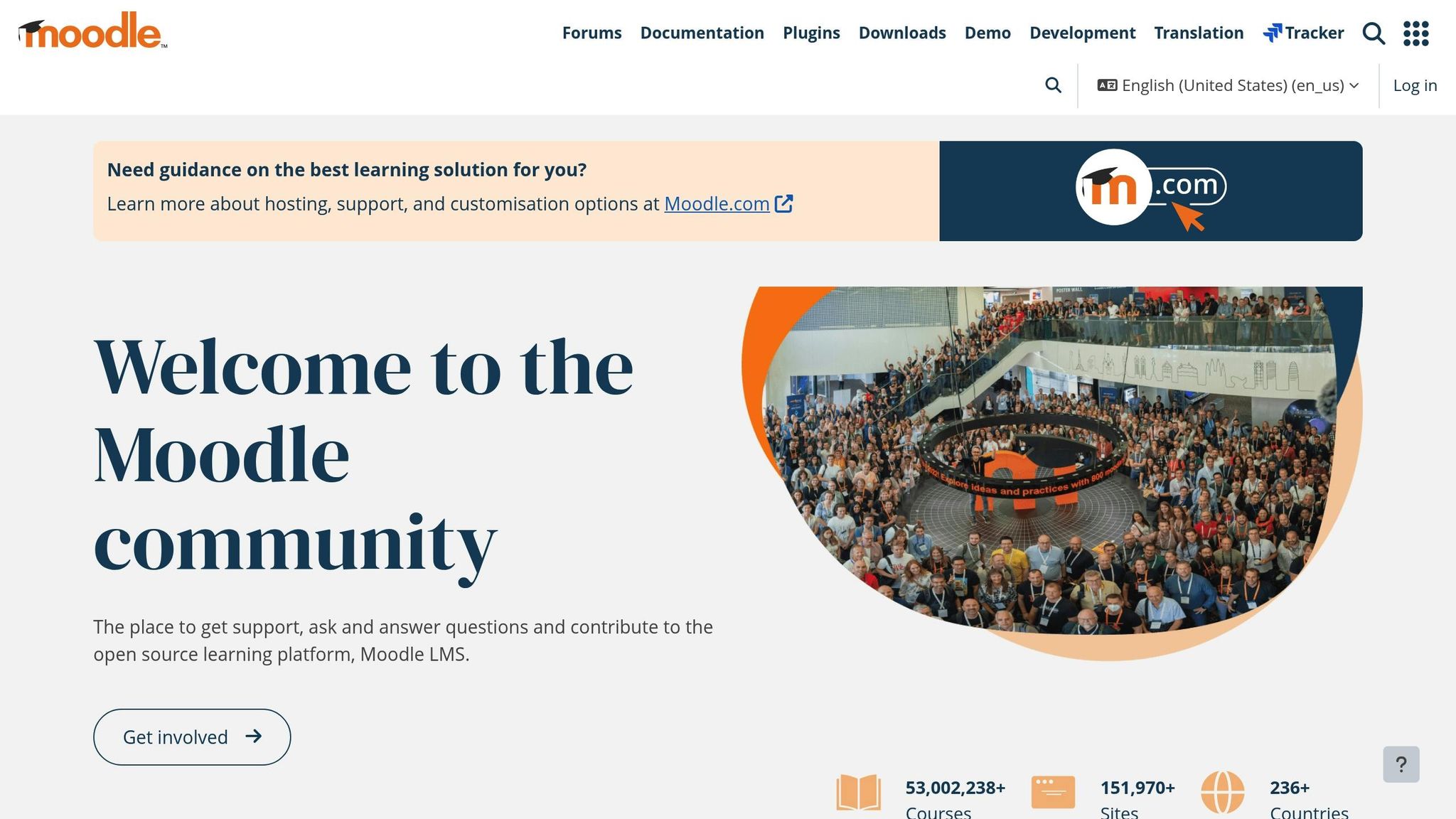
Moodle is a globally recognized open-source learning management system that has made a significant impact on education worldwide.
Features
Moodle’s open-source nature offers complete flexibility, allowing organizations to customize everything from branding to integrations without being tied to a specific vendor.
It includes collaborative tools like discussion forums, wikis, and peer assessments, which encourage group-based learning and interaction. The Moodle Mobile app ensures learners can access content anytime, even offline, with syncing capabilities.
For assessments, Moodle supports a variety of question types, such as multiple choice, essays, drag-and-drop, and calculated questions. Teachers can create question banks, automate grading, and provide detailed feedback using rubrics and annotations.
The platform also features robust reporting and analytics tools. These help administrators track learner progress, course completion rates, and engagement levels, making it easier to evaluate educational outcomes.
These capabilities highlight Moodle's flexibility and its emphasis on community-driven learning.
Target Audience
Moodle is designed for a wide range of users, from K–12 schools to universities. It’s also a great fit for non-profits and government agencies that prioritize data control and cost-effective training. Its open-source model is especially appealing to organizations with in-house technical expertise or IT teams, particularly those focused on data privacy and security.
Pricing
The core version of Moodle is free. However, implementation costs depend on hosting and customization choices. Options include self-hosting, working with certified Moodle Partners, or using MoodleCloud’s scalable plans.
Certification Options
Moodle allows for the automatic generation of certificates and digital badges upon course completion. It also supports integration with external credentialing systems and can issue digital certificates, including official academic transcripts and continuing education certifications, for institutions that require them.
AI/Personalization Tools
While Moodle’s built-in AI capabilities are limited, its plugin ecosystem expands functionality. Plugins can add features like automated content recommendations, plagiarism detection, adaptive learning, chatbots, and essay scoring.
Additionally, Moodle’s competency-based framework supports personalized learning paths, enabling learners to progress at their own pace while mastering specific skills or knowledge areas.
8. Docebo Learn
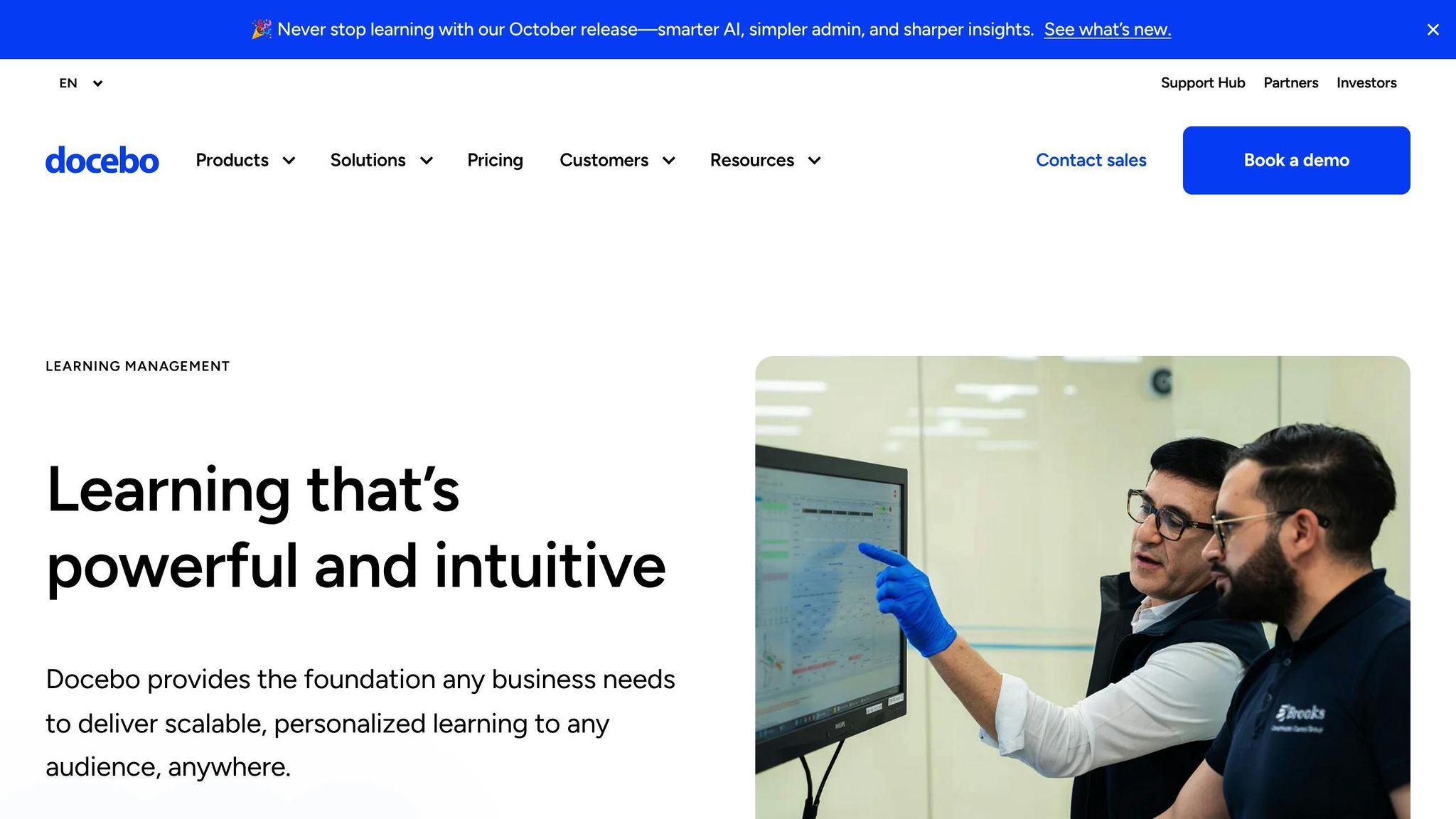
When it comes to modern e-learning platforms, Docebo Learn earns attention for its advanced AI tools and adaptable framework. It's designed to deliver tailored, engaging learning experiences that meet the needs of today's organizations.
Features
Docebo Learn leverages AI to automatically curate content based on individual user behavior. It even includes a virtual learning assistant that offers personalized recommendations and motivates users to achieve their training goals.
The platform also emphasizes social learning, enabling peer-to-peer knowledge sharing through discussion boards and collaborative spaces. This setup encourages users to exchange ideas and share content within their learning community.
One standout feature is its multi-domain architecture, which allows organizations to create separate learning environments for different departments, regions, or customer groups - all while maintaining centralized control. This is especially useful for managing diverse training programs across various business units.
Additionally, Docebo Learn supports extended enterprise learning, offering dedicated portals to train external audiences like customers, partners, and vendors. Its mobile-first design ensures learners can access content seamlessly across devices, even offline, with automatic syncing once they're back online.
These features make Docebo Learn an excellent choice for organizations with complex and varied training needs.
Target Audience
Docebo Learn is best suited for mid-to-large enterprises aiming to scale their training and development efforts. It works particularly well for industries like technology, healthcare, manufacturing, and retail - especially for companies managing distributed teams or intricate organizational structures. Its data-driven approach and flexibility make it a strong fit for businesses with diverse training requirements.
Pricing
The platform uses a per-active-user pricing model, with costs depending on the number of users, included features, and any customization needs. For extended enterprise capabilities or specialized implementation services, you'll need to reach out to the vendor for details.
Certification Options
Docebo Learn simplifies certification management with automated certificate generation, digital badges, and compliance tracking to ensure regulatory requirements are met.
AI and Personalization Tools
The platform excels in personalization, analyzing user behavior to create tailored learning paths and identify skill gaps. Its predictive analytics help administrators detect potential issues early, allowing for timely interventions that enhance learning outcomes.
9. Skilljar
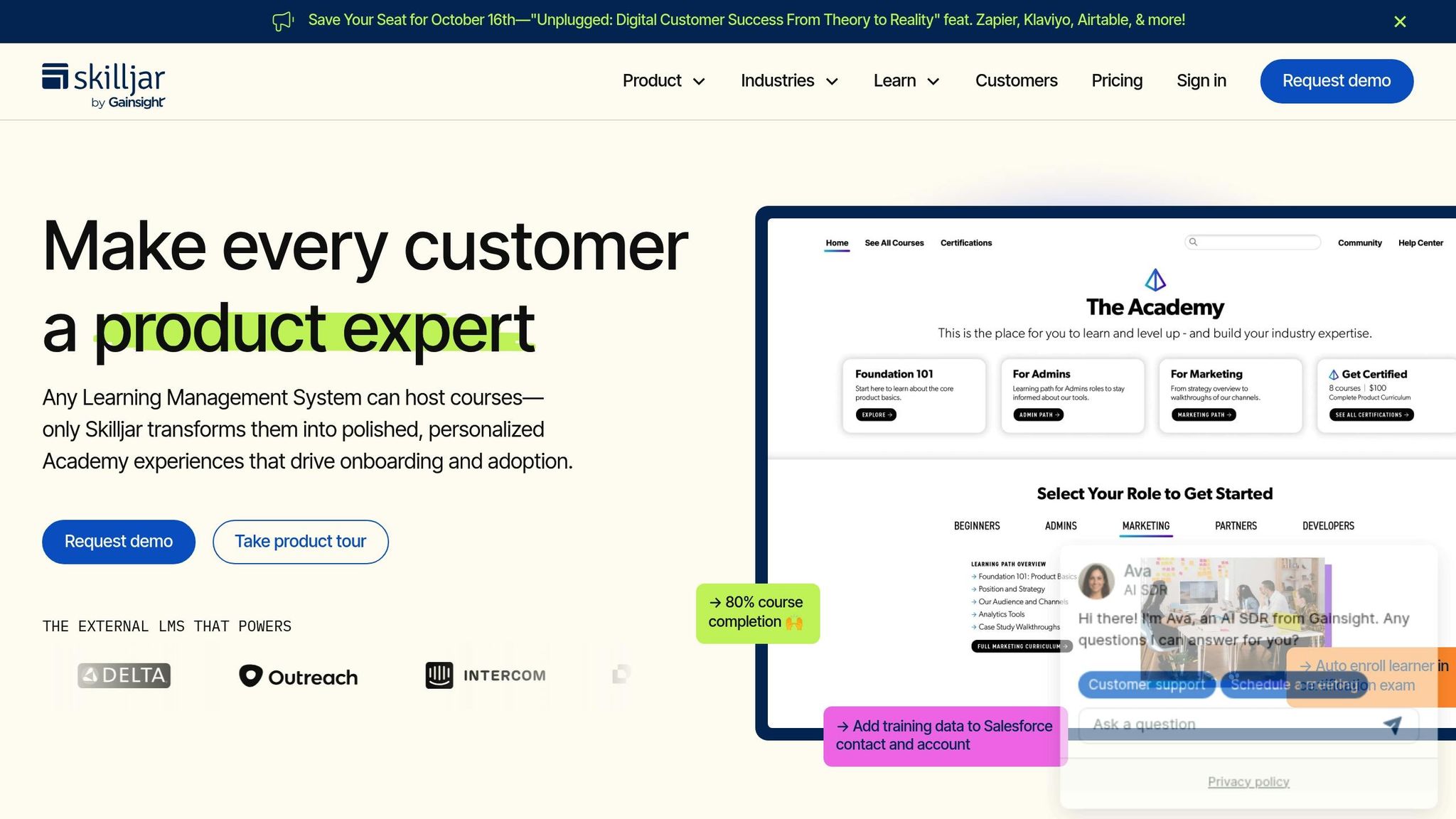
Skilljar is a customer education platform that empowers organizations to deliver training to external audiences like customers, partners, and channel partners. Its design emphasizes scalability and engagement, making it a game-changer for customer onboarding, product training, and certification programs. By offering structured learning experiences, Skilljar helps businesses reduce support tickets, boost product adoption, and improve retention rates.
With branded learning portals, automated course assignments, and detailed progress analytics, Skilljar provides tools that track both learner success and business outcomes. Its course authoring tools support a variety of formats, such as videos, documents, and interactive assessments, and its mobile-responsive design ensures learners can access content from any device. The platform also integrates seamlessly with CRM systems, marketing tools, and customer success platforms, embedding education into the broader customer journey.
Features
Skilljar offers white-label customization, enabling businesses to design branded learning experiences aligned with their corporate identity. Features include automated enrollment tied to customer segments or product purchases, real-time analytics dashboards, and certification management tools. Its API-first architecture ensures smooth integration with existing systems, while built-in e-commerce capabilities allow businesses to monetize training programs and certification fees.
Target Audience
Skilljar is tailored for B2B companies, SaaS providers, and technology vendors that need to train external audiences at scale. It’s particularly useful for businesses with complex products requiring in-depth onboarding, channel partner programs, or customer certification initiatives. Companies aiming to monetize training content or reduce customer support costs through self-service education will find Skilljar an excellent fit.
Pricing
Skilljar operates on a tiered pricing model based on the number of active learners and desired features. Plans start with options for smaller customer bases and scale up to enterprise solutions designed for thousands of learners. Custom pricing is available for organizations with unique integration needs or advanced analytics requirements.
AI and Personalization Tools
Skilljar uses data analytics to craft personalized learning paths based on factors like customer segments, product usage, and learning history. Automated recommendations guide learners toward relevant content, while predictive analytics highlight customers who could benefit from additional training. These tools not only enhance the learning experience but also help businesses improve product adoption and reduce churn.
This focus on tailored learning solutions sets the stage for our final platform, which approaches enterprise training from another perspective.
10. WorkRamp
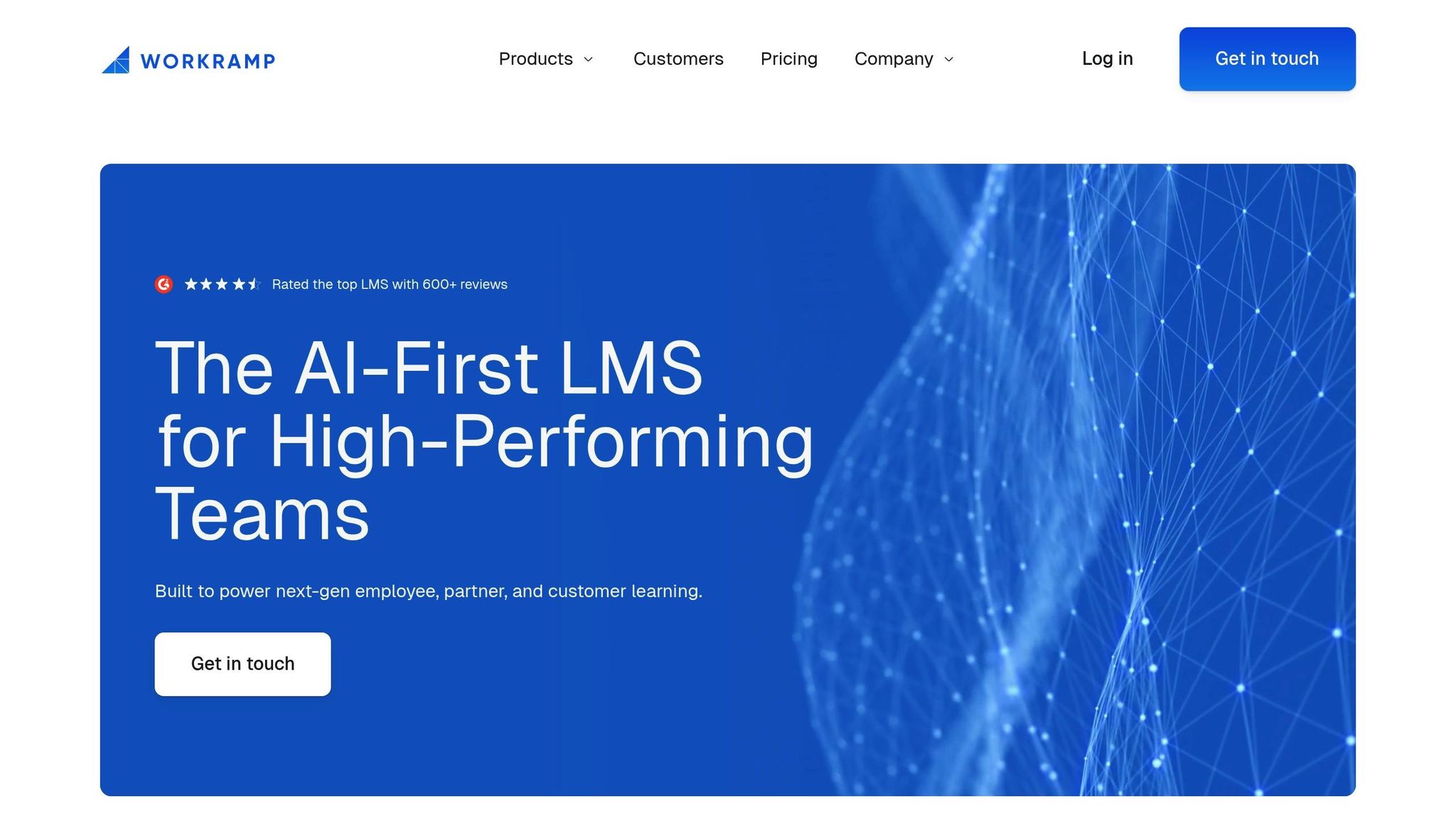
WorkRamp is a versatile learning platform designed for enterprises that need to manage training for multiple audiences. Unlike traditional systems that cater to just one group, WorkRamp takes a unified approach, enabling organizations to oversee various training initiatives from a single platform. This makes it an excellent choice for companies aiming to train diverse groups while maintaining consistent branding and reporting.
What sets WorkRamp apart is its ability to scale learning programs across departments and external stakeholders without the need for separate systems. Its modern, mobile-friendly design ensures users can access training materials seamlessly across devices. For administrators, the platform simplifies content creation and management, helping connect learning programs directly to measurable business goals like performance improvements and revenue growth.
Features
WorkRamp’s features are built around its three core areas: employee learning, customer training, and partner education. The platform includes advanced tools like video creation capabilities and SCORM compliance, making it easy to develop engaging and professional content. Organizations can also create branded learning portals, ensuring a consistent look and feel for all audiences.
The analytics dashboard provides real-time insights into learner progress and the effectiveness of training materials, linking these insights to business outcomes. With automated workflows, tasks like assigning courses based on job roles, onboarding stages, or customer types become effortless. The platform also supports live virtual classrooms, discussion forums, and social learning tools to foster collaboration and peer-to-peer knowledge sharing.
WorkRamp integrates smoothly with popular tools like HRIS systems, CRM platforms, and business intelligence software, ensuring training data fits seamlessly into existing workflows.
Target Audience
WorkRamp is tailored for mid-market to enterprise-level organizations managing complex, multi-audience training needs. It’s particularly useful for companies in industries like technology, SaaS, and professional services, where training employees, customers, and partners is critical.
The platform supports sales teams with tools to boost revenue enablement, while customer success teams use it to lower churn through proactive education. HR departments rely on WorkRamp for onboarding and ongoing professional development. Additionally, companies with remote or distributed teams benefit from its virtual learning capabilities, which make training accessible anytime, anywhere.
Pricing
WorkRamp follows a subscription-based pricing model that adapts to the number of active learners and the features required. The platform offers distinct pricing tiers for employee learning, customer education, and partner training, allowing organizations to start small and expand as their needs grow.
- Starter plans: Ideal for smaller teams with basic training needs.
- Enterprise packages: Include advanced features like detailed analytics, custom integrations, and dedicated support.
- Custom pricing: Available for organizations with unique requirements, including personalized implementation services and strategic consultation.
This flexible pricing structure allows businesses to scale their learning initiatives without overcommitting upfront.
AI and Personalization Tools
WorkRamp leverages AI to enhance the learning experience. By analyzing user behavior, performance data, and role-specific needs, the platform recommends courses, identifies knowledge gaps, and surfaces the most effective training materials for each learner.
With predictive analytics, administrators can spot at-risk learners early and intervene before they fall behind. The platform’s personalization engine adjusts content difficulty and pacing based on individual progress, ensuring every learner has a tailored experience that aligns with their skills and preferences.
These AI-driven insights also help organizations fine-tune their training programs by identifying which formats and delivery methods work best for different groups, making learning more impactful and efficient.
Platform Comparison: Strengths and Weaknesses
Selecting the right LMS involves balancing strengths and trade-offs that align with your organization's specific needs.
Enterprise platforms like Upskillist, Absorb LMS, and Docebo Learn cater to complex organizational requirements. These systems excel in offering advanced analytics, personalized learning experiences, and seamless integration with business tools. For example, Upskillist includes AI-powered features like Compass and Pathfinder, alongside accredited courses in over 100 subjects and flexible scheduling options. However, these platforms often come with higher costs and longer implementation times, making them a significant investment.
On the other hand, academic-focused platforms like Canvas LMS and Blackboard Learn are widely adopted in educational institutions. They boast features like detailed gradebooks, assignment management, and strong communication tools, making them ideal for schools and universities. That said, they may lack the flexibility and features needed for corporate training environments.
For small to medium-sized businesses, platforms like TalentLMS and Litmos stand out for their simplicity and quick setup. Their user-friendly designs make them easy to implement, but this ease of use can sometimes limit advanced customization and reporting capabilities.
Then there’s Moodle, a popular open-source option offering unmatched customization. While it’s cost-effective and highly flexible, Moodle demands technical expertise for setup and maintenance, which could be a hurdle for organizations lacking IT resources.
Here’s a quick comparison of some popular platforms:
| Platform | Best For | Key Strength | Main Limitation | Pricing |
|---|---|---|---|---|
| Upskillist | Personal & professional growth | AI-powered personalization with accredited courses | Expanding course library | 7-day free trial, then subscription |
| Absorb LMS | Large enterprises | Comprehensive analytics and reporting | Complex setup process | Pricing varies |
| Blackboard Learn | Higher education | Extensive academic tools | Fewer corporate training features | Pricing varies |
| Canvas LMS | K-12 and higher education | Intuitive interface for educators | Less focus on business training | Pricing varies |
| TalentLMS | Small to medium businesses | Quick deployment | Limited advanced customization | Pricing varies |
| Litmos | Corporate training | Mobile-friendly design | Basic reporting features | Pricing varies |
| Moodle | Budget-conscious organizations | High customization potential | Requires technical expertise | Free (hosting costs apply) |
| Docebo Learn | Multi-audience training | AI-driven learning recommendations | Higher cost for smaller teams | Pricing varies |
| Skilljar | Customer education | Effective external learner management | Limited employee training options | Custom pricing |
| WorkRamp | Multi-audience enterprises | Unified training approach | Premium pricing structure | Custom pricing |
Beyond features, factors like pricing, implementation time, and mobile readiness play a critical role in the decision-making process. For example, while Moodle is free to use, organizations often need to budget for hosting, customization, and maintenance services. In contrast, enterprise solutions may come with higher costs but justify the expense with extensive support and advanced features - though they may not suit every organization’s budget.
Implementation timelines also vary widely. Some platforms, like TalentLMS, can be deployed within days, while more complex systems like Absorb LMS might take several months - something to consider if you’re working with tight deadlines.
Mobile accessibility is another key differentiator in 2025. Platforms like Litmos and Upskillist, designed with a mobile-first mindset, provide a seamless experience across devices. Meanwhile, older systems may not be as well-optimized for mobile use, which could impact learner engagement.
AI and adaptive learning are becoming increasingly important. Platforms incorporating these technologies offer automated course recommendations and dynamic learning paths, whereas more traditional systems often rely on manual course assignments and basic tracking.
Lastly, integration capabilities are a critical factor for long-term success. Systems that integrate easily with HR platforms, CRM tools, and business intelligence software can streamline workflows, while those with limited integration options may require more manual effort to manage data.
Conclusion
Selecting the right LMS in 2025 means finding a platform that aligns with your unique goals and priorities. The options vary widely, from robust systems tailored for large enterprises to streamlined solutions perfect for smaller organizations.
For academic institutions, features like assignment management and grading tools are key, while smaller businesses often prioritize quick setup and user-friendly interfaces.
One standout for U.S.-based learners is Upskillist, which offers a compelling combination of AI-powered personalization through its Compass and Pathfinder tools, along with accredited courses spanning over 100 subjects. Its flexible scheduling is ideal for busy professionals, while globally recognized certifications provide a clear boost to career growth. Plus, the 7-day free trial allows users to explore the platform risk-free, making it easier to see its benefits firsthand.
As mobile learning and AI-driven customization become increasingly important, consider factors like budget, technical expertise, implementation timelines, and long-term goals. The best LMS will not only meet your technical and organizational needs but also provide meaningful, measurable outcomes for learners and organizations alike.
FAQs
How can I choose the right Learning Management System (LMS) for my organization in 2025?
Choosing the right LMS for your organization in 2025 starts with understanding your specific goals and priorities. Begin by looking at the core features - does the platform support SCORM or xAPI standards? Is it accessible on mobile devices? Does it offer robust analytics or AI-powered personalization? These features should align with your learning objectives, whether you're focused on corporate training, employee upskilling, or academic programs.
Don't overlook factors like ease of use, affordability, and scalability. A user-friendly platform that fits your budget and can grow alongside your organization is key. Also, consider the onboarding process and the level of support provided. A smooth implementation and reliable assistance can make a big difference in avoiding hiccups during deployment. By aligning these considerations with your needs, you'll be better equipped to choose an LMS that drives success in 2025.
What are the top trends in Learning Management Systems for 2025, and how can they help my business or school succeed?
In 2025, Learning Management Systems (LMS) are stepping up their game with features like AI-powered personalized learning paths, microlearning, and immersive tools such as VR and AR. These advancements help deliver custom-tailored content, boost engagement through short, focused lessons, and offer interactive, hands-on learning opportunities.
For businesses and schools, these technologies translate into greater efficiency, reduced costs, and more impactful training. Scalable and engaging LMS platforms not only improve knowledge retention but also simplify training processes, making it easier to address the specific needs of employees or students.
What should I look for when comparing the pricing of Learning Management Systems?
When looking at LMS pricing, it's important to think about how the pricing model matches your specific needs. Typical options include pay-per-user, pay-per-active-user, or flat-rate subscriptions. Take some time to figure out which model works best for your expected usage and budget.
Don’t stop at the base price - dig deeper into the total cost of ownership. This means factoring in potential hidden fees, setup costs, or extra charges for premium features. A platform might seem affordable upfront, but those additional expenses can add up quickly. Focus on the long-term value rather than just the initial cost.
Lastly, choose a pricing model that can grow with you. If your organization expands, the LMS should scale without becoming too expensive to maintain. Make sure the features included are worth the price and align with your specific training or learning objectives.

